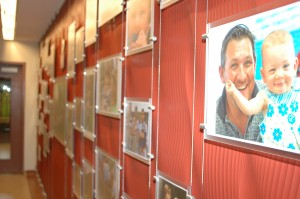
After a multimillion-dollar building project, Danbury Hospital has opened its new neonatal intensive care unit that will treat premature babies and other critically ill infants.
It”™s an amazing difference between what we could handle before and what we can handle now, said Edward James, chief of the new neonatal intensive care unit.
The facility is an $8 million investment by the hospital. The costs include $2 million in equipment upgrades and $6 million in construction costs. The new unit is four times the size of the old facility. Both are located in the campus”™ Stroock Building. The facility space was formerly an independent medical practice and storage for medical records that have since been digitized.
The project has upgraded the unit so it has the capability to handle more intensively ill babies. James said it was not a moment too soon; the old facility had reached its capacity.

“We literally out grew the space,” he said. “The growth in need for the facility was not as much from the number of babies with these types of illnesses, but the intensity of their sicknesses. With that you need better and more equipment and more staff so just physically the space you need grows.”
According to the U.S. Department of Health and Human Services, about 10 to 15 percent of newborns have complications. Common problems include premature or low-weight births, underdeveloped lungs, respiratory complications and infections. An estimated 400 babies were admitted to the Danbury neonatal intensive care unit in 2010.
The unit services include high-frequency jet ventilation, nitric oxide therapy, surfactant therapy and percutaneous central venous line placement. Its neonatal team transported six babies from New Milford Hospital to the unit since October.
The facility will feature technology like the Giraffe OmniBed, which facilitates access to babies by caregivers, limits noise and maintains optimal environmental temperatures.
The new facility will feature 16 individual rooms for patients and their families, all equipped with light, noise and temperature gauges in order to create the perfect environment for the particular patient.
“If you think about it many of these babies are premature, meaning they are still in need of development in the womb,” James said. “That”™s a very controlled environment, in an open patient space, as the old unit was, it can be hard to not have outside elements affect the environment. That can effect brain development and overall outcome.”
The center was designed by Connor Glass of design and architecture firm Perkins Eastman in Stamford.
The facility has what it calls its “graduate program,” where once neonatal babies and their families stay in touch with the hospitals staff and return for a once a year reunion event. A wall in the new facility will have rotating pictures of its ”˜graduates.”™ Graduates and their families were consulted in order to make improvements to the facility drawing on their experiences.
“We”™ve had all sorts of different cases and it gave us a good representation of what a family would be looking for in that time,” said Maryalice Cullen, nurse manager of the neonatal ICU.
Cullen said through those programs the hospital has added showers to rooms for families that need to stay overnight with their babies; the older facility had no family space.
“It”™s hard because often you don”™t anticipate needing your baby to stay in a NICU,” James said. “It”™s a lot of stress for the families, it can be similar to a post traumatic stress disorder for family members, it is that kind of heightened level of stress.”


















